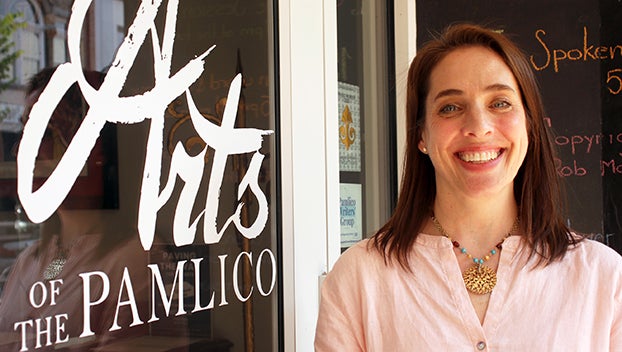PORT TOWN: Historic port of Washington recreated piece by piece
Published 8:13 pm Wednesday, September 17, 2014

VAIL STEWART RUMLEY | DAILY NEWS
MAKING HISTORY: Douglas Alvord takes a break in the Main Street studio to talk about the Historic Port of Washington exhibit. Alvord, a maritime historian and artist, is painting a 4-foot by 10-foot mural that will be the centerpiece of the October exhibit at the Turnage Theater gallery.
Douglas Alvord is a maritime historian and artist — one who breathes life into waterfronts of the past through his paintings. His current project: the focal point of the Historic Port of Washington exhibit, a 4-foot by 10-foot depiction of one of the centers of North Carolina shipping and shipbuilding circa 1880 to 1920.
And it’s a challenge, Alvord said.
He spends part of his day painting, part of it poring through old maps and letters, old photographs and comparing those to what he’s learned from conversations with, and memories of, other Washingtonians. He and several others — Whiting Toler, Pat Mansfield and Ray Midgett, with their wealth of local history — are piecing together that history, recreating a commercial center that may have existed during the peak of Washington’s maritime activity.
“We’re saying this is circa 1880 through 1920, but you almost have to pick a date,” Alvord said. “It changed so rapidly. We don’t have enough information to say it looked like this on this date.”
So, Alvord and the Historic Port of Washington team are approximating a place in time, painting out a composite of maritime Washington, to unveil at the exhibit’s opening on Oct. 23 — a date that corresponds with the North Carolina Maritime History Council’s annual meeting that will be held in Washington the same weekend.
Anyone who knows a little bit about Washington history knows that the waterfront was once a bustling, thriving center of commerce where boats loaded with freight and passengers traveled up the Tar River and came back stocked with goods, which were then loaded on ships destined for far off places.
Alvord knows people are aware of Washington’s maritime past, but he believes they aren’t really aware of how important a place Washington holds in maritime history.
Framed by the Fowle, Havens and Myers properties on western end of the Washington waterfront — they still exist today — and an oyster cannery on the eastern side, the commercial district included grain and lumber mills, shipyards and freight and passenger terminals. A cooperage did brisk business building barrels, because in that era, everything was shipped in barrels. The Washington waterfront was a thriving commercial port, the second-oldest in the state and, at one point, the largest ship-building port in the state.
Alvord is employing just as much of his maritime knowledge as his painting skills as he works steadily toward the mural’s completion. The mural may be the centerpiece of the coming exhibit, but it won’t be the only item of interest on display: archival photographs, artifacts, maps and paintings will share the gallery space at the Turnage Theater. Alvord said a collection of local ballast rocks — their lands of origin traced by archaeologists — will also be on display. The rocks acted to weigh down ships during return voyages with less or no cargo than the original foray; picked up in one port, stones from far off places were deposited in port towns across the world.
Alvord will certainly finish the Historic Port of Washington mural by the exhibit’s opening date, but to him and others committed to the project, it’s only the beginning.
“Our goal is use this exhibition as a starting point to continue expanding the cultural and maritime aspects of the Port of Washington — and the City of Washington,” Alvord said.
Alvord is also asking for the public’s help moving forward: “We want input. We’re asking people to stop and think and share what they might know in stories, records, photos, logs — anything they feel is germane to what Ray (Midgett) and I are trying to do.”
Alvord can be found working at his temporary studio at 144 W. Main St., Washington, on most days. To share history with the Historic Port of Washington project, or to find out more information, visit www.facebook.com/historicportofwashington.





